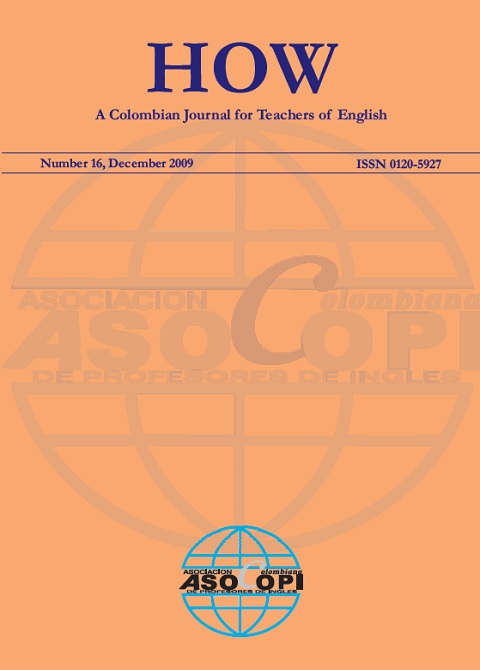Improving Reading Comprehension Skills through Reading Strategies Used by a Group of Foreign Language Learners
Main Article Content
Abstract
A research study included the examination and implementation of a variety of strategies in order to improve students’ reading comprehension skills in a foreign language. Reading is the process of identification, interpretation and perception of written or printed material. Comprehension is the understanding of the meaning of written material and involves the conscious strategies that lead to understanding. The reading strategies are conscious techniques or unconscious processes employed by readers in their attempt to make sense of the written text (Barnett as cited by Gascoigne, 2005). Thus, the main goal of this piece of research was to implement some reading strategies in 2 elementary courses in EFL in order to obtain better results in the middle and long term in class and on ECAES, MICHIGAN, MELICET and PET tests.
Article Details

This work is licensed under a Creative Commons Attribution-NonCommercial-NoDerivatives 4.0 International License.
The authors of the manuscripts accepted for publication in HOW journal are required to sign a nonexclusive license agreement allowing ASOCOPI to reproduce the full text on the Internet or in any other available source. Authors retain copyright of their manuscripts with the following restrictions: first publication is granted to ASOCOPI; nonexclusive agreements with third parties can be established as long as the original publication in the HOW journal is properly acknowledged.
References
Baker, L. & Brown, A. L. (1984) Metacognitive skills and reading. In Pearson, D. (Ed). Handbook of reading research (pp. 353-394). New Jersey: Lawrence Erlbaum Associates, Inc.
Bensoussan, M. (1998). Schema effects in EFL reading comprehension. Journal of Research in Reading, 21(3), 213-227.
Bormuth, J. R. (1969) An operational definition of comprehension instruction. In Goodman, K.S. & Fleming, J.T. (Eds.), Psycholinguistics and the teaching ofreading. (pp. 48-60) Newark: International Reading Association.
Calfee, R. C. & Curley, R. (1984) Structures of prose in content areas. In Flood, J. (Ed.) Understanding reading comprehension: Cognition, language and the structure of prose (pp.161-180). Newark: International Reading Association.
Czico, C., Greenleaf, C., Hurwitz, L. & Schoenbach, R. (2000) What is reading? An excerpt from “Reading for Understanding”. The Quarterly, 22(3), Retrieved from http://www.nwp.org/cs/public/print/resource/787
Gascoigne, C. (2005). Toward an understanding of the relationship between L2 reading comprehension and grammatical competence. The Reading Matrix, 5(2), Retrieved from http://www.readingmatrix.com/articles/gascoigne/article.pdf
Hosenfeld, C. (1976) Discovering our students’ strategies. Foreign Language Annals, 9, 117-130.
Jones, R. C. (2007) ReadingQuest.Org. Strategies for reading comprehension. Comparison contrast chart. Retrieved from http://www.readingquest.org/strat/compare.html
Kucer, S.B. (2005). Dimensions of literacy: A conceptual base for teaching reading and writing in school setting, 2nd edition. Mahwah, NJ: Lawrence Erlbaum Association.
Ogle, D. (1986) ReadingQuest.Org. Strategies for reading comprehension. K.W.L. Retrieved from http://www.readingquest.org/strat/kwl.html
Palincsar, A. & Brown, A. L. (1984 – 1986). Reading quest.Org. strategies for reading comprehension. Reciprocal teaching. Retrieved from http://www.readingquest.org/strat/rt.html
Ruddell, R. B. & Unrau, N. J. (Eds.) (1994). Theoretical models and processes of reading. California: International Reading Association.
Sheng, He Ji (2000). A cognitive model for teaching reading comprehension. English Teaching Forum, 38(4).
Steffensen, M. S. & Joag-Dev, C. (1984). Cultural knowledge and reading. In Alderson, J.C. & Urquhart, A. H. (Eds.) Reading in a foreign language (pp. 48-61). London: Longman.
Urquhart, A. (1987) Reading in a foreign language: Comprehension and interpretations. Language Learning Journal. DOI: 10.1080/09571739285200101
Wang, S. & Han, S. (2001) Six C's of motivation. In Orey, M. (Ed.), Emerging perspectives on learning, teaching, and technology. Retrieved from http://www.coe.uga.edu/epltt/6csmotivation.htm.

